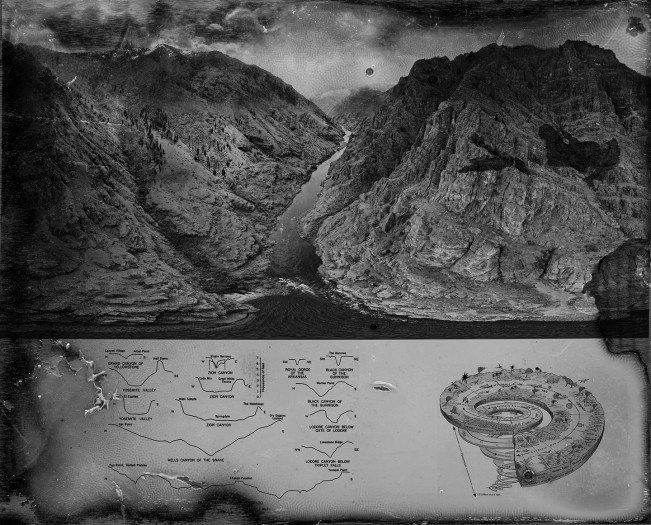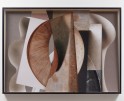The Hand in Nature, Dennis DeHart: Aerial and Fossils
The Hand in Nature: a week of photographs that manipulates how we see and foresee our environment.
Photographs help us process what is happening in the world, and this week we’ll be following photographers whose work inspects humans’ impact on the earth. More importantly, the posts will focus on how each photographer uses their hand in the manipulation of imagery. Many of the photographers’ works curiously demonstrate our history and future relationship with the earth.
Today we will discuss Dennis DeHart‘s two series, Exotic Terrane, and Aerial + Fossils.
“History turns space into place” is the first line of the first chapter of Liz Well’s 2012 book Land Matters, where Wells discusses that landscapes are not void of people but a social and cultural construction. It may be hard to relate to Well’s words, for we are trained to look upon a landscape and not see ourselves as part of it. The notion of looking at landscapes has not changed; we still desire to see landscapes for their beauty and reverence. While Dennis’s work plays with traditional and new technological tropes of photographing landscapes, he also questions this language. He ultimately tries to understand what makes a place, its history, and how we can create a new understanding of place over time.
Both series, Exotic Terrane and Aerial + Fossils, began in 2020 with the pandemic and Dennis’ curiosity about Hell’s Canyon Wilderness and National Recreation Area, (located along Eastern Oregon, Washington, and Idaho borders).
Exotic Terrane is a preface to Aerial + Fossils, where Dennis spends years getting to know this location. He travels by foot, bike, and boat to explore all parts of Hells Canyon, areas easily open to the public, and the less explored regions. These explorations are documented by photographing his journeys and creating beautiful imagery on foot in the 7 Devils Wilderness, part of the Hells Canyon Wilderness. He also took images of the National Recreation land with his drone.
Along with the gorgeous imagery he produces, his audience also sees field notes represented as social media posts. These posts function much like personal journals. Dennis notes and shares his experiences, feelings, and discoveries throughout his explorations and study of the history of Hells Canyon. These social media field notes are stories within themselves that create an entryway to the personal narrative of the transition of space developing into a more personal place for Dennis.
But what begins to be revealed in this series and is true of all Dennis’ past photographic series is Dennis’ desire to understand this specific location concerning contemporary issues related to public lands and mythologies tied to western spaces. Dennis shares with his audience what he read during this exploration process. Some titles include The End of Myth: From the Frontier to the Border Wall in the Mind of America, Mediocre: The Dangerous Legacy of White Male America, This Land: How Cowboys, Capitalism, and Corruption are Ruining the American West and Unsettled Ground, The Whitman Massacre and its Shifting Legacy in the American West.
While exploring Hells Canyon, Dennis looks at it with a new contemporary lens. He provides evidence of how humans have inhabited this public space and how the western mythologies have impacted how we perceive it, but he also questions how it has evolved on its own.
With closer examination, the work that could initially be seen at its surface as gorgeous imagery is now more complicated. It’s Dennis’s second series, Aerial + Fossils, where things dramatically depart from this traditional documentary approach.
Two things are happening in Aerial + Fossils that make it so magical. First, Dennis explores his relationship with Hells Canyon further by creating topographical objects from his 360-degree VR drone images. He constructs sculptural objects from these topographical-quality landscape photographs, which he documents as formal archetypes. There is something interesting about taking sophisticated digital data, positioning and composing it in physical three-dimensional form to later compose again by filtering it and presented it as a two-dimensional form. Through this physical abstraction, we get a new understanding of how this location could be reimagined.

© Dennis DeHart, photo objects created with aerial VR 360 imaging, Hells Canyon, archival pigment prints, 2022
Secondly, Dennis presents photographs of fossilized sea life found in Hells Canyon. These fossils are approximately 200 million years old, and part of the collection housed in the University of Montana’s Geosciences department. These are shown in a similar macro scale as the photo objects Dennis creates. The fossils appear familiar in their formal compositional construction, but there is a play of focus that makes them feel unfamiliar and peculiar. Both the images of fossils and the photo objects play with the idea of the macro, micro, and the sense of time.
But his use of black and white imagery makes this series so rich with mystery. All the images are bold and full of topographic texture. One might get disoriented as they look between pictures of the terrain, Dennis’s hand-made photo objects, and fossils. The imagery starts to bleed into one another and respond to each other in this metaphysical way. What are we looking at? Do these images represent a past or future representation of Hells Canyon, and what is our relationship with this space?
I don’t think Dennis gives us any specific answers, as he continues to explore. He is interested in looking at the non-linear impacts on a complex system. Dennis says, he is “compelled by deep time, and the relative incomprehensibility we have, of truly understanding geologic change. I am also interested in the richness of an ecologically world view, focused on the importance of interdependency and how everything is interconnected.”
In his last experimentations, he introduces film-related alternative processes, which creates illusionary layers, textures and other visuals insertions to yet again dissect the landscape. There is a genuine curiosity and progression between Exotic Terrane and Aerial + Fossils as Dennis gives himself time to analyze the Hells Canyon terrain. One series couldn’t work without the other, and what is seen with both works is a more significant nuanced question of how we relate to our surroundings.
At the bottom of the Aerial + Fossil page on Dennis’s website, he presents a quote by James Bridle from Ways of Being, Animals, Plants, Machines: The Search for Planetary Intelligence. James Bridle says, “In order to change ourselves, to take on different ways of thinking about the world, we need new ways of seeing it. We are accustomed, largely by scientific practice, to take things apart, separating them into their component attributes, fixing them for study, and piece by piece reducing their collective agency until they have non at all. But this is the opposite of ecology, which seeks to find connections between things and to resolve them into greater, interconnected systems. The lens required now is not a microscope, but a macroscope: a device for seeing at a far vaster scale-both in space and time-than we are use to.”
This quote profoundly explains Dennis DeHart’s relationship with the complexity of multi-disciplinary documentation of the landscape. It also reminds us how important it is to make art, reevaluate what seems evident, and allow ourselves to explore. This is where science and art are intertwined. We need the freedom to be illogical and adhere to the potentially anti-formality of artmaking to enable more questions.
To see more of Dennis Dehart’s project, check out his work on his website, here.
Follow Dennis on Instagram at @ddehart.
Dennis’ bio:
Dennis DeHart is a photographic artist, whose interdisciplinary projects are informed by the connections, conflicts, and intersections of the natural and cultural worlds. Dennis has exhibited broadly, including dozens of solo exhibitions, numerous media and art contexts, and over 100 group shows nationally and internationally. He as received grants and support from the New York Foundation for the Arts, the Arizona Arts Commission, Santa Fe Art Institute, Artist Trust, and others. Dennis photographs are included in private and public collections including the J. Paul Getty, George Eastman House, The City of Phoenix, and the Museum of Fine Arts, Houston.
Dennis received his MFA in photography from the University of New Mexico in 2002. He previously served as an Assistant Professor of Photography with the State University of New York College at Buffalo and is currently an Associate Professor of Art with Washington State University in Pullman, Washington.
Sarah Knobel is a photographer, video and installation artist that works with everyday items to find new ways to identify our relationship with ideas of the natural, artificial, beautiful and repulsive. Her work has been featured in exhibitions nationally and internationally, which includes Miami, Seattle, Portland, Kansas City, Washington DC, Germany, Belgium, Korea and Greece. Sarah holds an MFA in Photography from the Design Architecture Art and Planning Program at the University of Cincinnati and a BFA in Studio Art from Texas State University. She is currently an Assistant Professor of Art at St. Lawrence University in Canton, New York.
Follow Sarah on Instagram at @sknobel.
Posts on Lenscratch may not be reproduced without the permission of the Lenscratch staff and the photographer.
Recommended
-
Bill Armstrong: All A Blur: Photographs from the Infinity SeriesNovember 17th, 2025
-
Robert Rauschenberg at Gemini G.E.LOctober 18th, 2025
-
Erin Shirreff: Permanent DraftsAugust 24th, 2025
-
Shelagh Howard: The Secret KeepersJuly 7th, 2025
-
Michelle Leftheris: Time, Nature & TechnologyJune 11th, 2025























































































